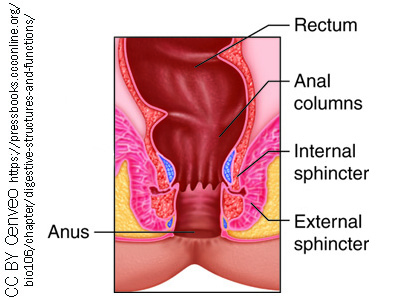Defecation
Jim Hutchins
Objective 9: Identify the process that expels feces (defecation).

The independent action of the enteric nervous system causes mass movement of chyme, and then feces, in the digestive tract.
Chyme is the watery slurry made by the stomach, which passes through the small intestines so that absorption of nutrients can occur. As the chyme leaves the pyloric valve of the stomach and enters the duodenum, the gall bladder adds bile, a biological soap that emulsifies fats so they can be absorbed. At the same time, the pancreas releases digestive enzymes, to break down nutrients into small molecules that can be absorbed, and sodium bicarbonate, to neutralize the stomach acid. The process of removing water from chyme begins in the small intestine.
Chyme enters the large intestine through the ileocecal sphincter. Most of the water has been absorbed at this point, but the large intestine continues water resorption to turn the loose, watery feces into a solid bolus (mass). If the large intestine is irritated or inflamed, this water resorption does not occur and the feces is relatively unchanged between the ileocecal sphincter and anus, a condition familiar to most of us as diarrhea.
In this way, fecal boli are delivered continuously to the rectum, where they stretch out (distend) the bowel wall. When that condition is detected, the urge to defecate is felt consciously and acted upon by the prefrontal cortex, insula, and anterior cingulate cortex.
At this point, the stretching of the rectum is conveyed via the pelvic nerve to the defecation centers in the sacral spinal cord. This causes an activation of the parasympathetic nervous system, with long preganglionic axons releasing acetylcholine onto muscarinic receptors.
In the sigmoid colon and rectum, acetylcholine is released onto the myenteric plexus (also called Auerbach’s plexus), a network of nerve cells in the wall of the bowel. This increases the motility of the smooth muscle that makes up the wall of these organs.
At the same time, release of acetylcholine onto the internal anal sphincter causes a relaxation of this ring of smooth muscle. Defecation is now imminent.
The only thing preventing defecation from happening is the external anal sphincter, a voluntary muscle in the pelvic floor muscle group. When the individual feels it is appropriate, the cortical areas which control defecation activate Onuf’s nucleus in the sacral spinal cord, as described for urination in the previous chapter. The individual makes a Valsalva maneuver, which increases intra-abdominal pressure and helps to expel the feces. (Valsalva maneuvers also change the blood pressure and heart rate, which is why many people have an increase in headache pain or even die when straining on a stool.) When the abdominal pressure increases, and the internal and external anal sphincters are open, feces is expelled from the body (defecation).
Media Attributions
- Defecation structures © Cenveo adapted by Jim Hutchins is licensed under a CC BY (Attribution) license

